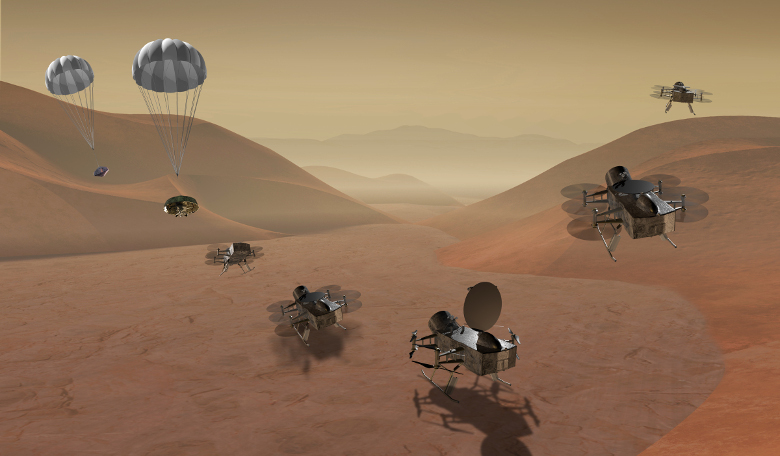Out of 12 proposals submitted in April under its New Frontiers program, NASA has announced that either a return trip to comet 67P/C-G or Saturn’s moon Titan will be the next target for a future Solar System mission.
The two finalists battling it out for the chance to explore their destination of choice, are the proposed Comet Astrobiology Exploration Sample Return (CAESAR) mission or Dragonfly. A launch date of the mid-2020s is planned for whoever is selected as the winner.
Led by Steve Squyres of Cornell University in Ithaca, New York, CAESAR seeks to return a sample from comet 67P/Churyumov-Gerasimenko to determine its origin and history. The comet has already been studied by ESA’s Rosetta spacecraft and it is now the final resting place of the Philae lander. Philae touched down on 12 November 2014, but its mission did not quite go to plan as it bounced when its anchoring harpoons failed to deploy. Nonetheless, several of the instruments on the lander made the first direct analysis of a comet and took images from the comet’s surface.
Dragonfly on the other hand is a dual-quadcopter lander that would take advantage of the environment on Saturn’s moon Titan, to fly to multiple locations and study the prebiotic chemistry and habitability of dozens of sites, some hundreds of miles apart.
If Titan was not gravitationally bound to Saturn, then the moon could be considered a planet as it is larger than Mercury. It is the only object in space other than Earth where clear evidence of stable bodies of surface liquid has been found and the only moon known to have a dense atmosphere.
The drone-like rotorcraft would also be able to sample materials and determine surface composition, monitor atmospheric and surface conditions, perform seismic studies and image landforms to investigate geological processes on Saturn’s largest moon. Elizabeth Turtle from the Johns Hopkins University Applied Physics Laboratory (APL) in Laurel, Maryland, is the lead investigator, with APL providing project management.
Both missions will receive funding through to the end of 2018 to further develop and mature their concepts. “This is a giant leap forward in developing our next bold mission of science discovery,” said Thomas Zurbuchen, associate administrator for NASA’s Science Mission Directorate in Washington. “These are tantalizing investigations that seek to answer some of the biggest questions in our solar system today.”
At the same announcement, NASA also advised that two mission concepts will receive technology development funds to prepare them for future mission competitions. These are the Enceladus Life Signatures and Habitability (ELSAH) mission and the Venus In situ Composition Investigations (VICI).
ELSAH will receive funds to develop cost-effective techniques that limit spacecraft contamination and thereby enable life detection measurements on cost-capped missions, while the VICI mission concept will look at developing the Venus Element and Mineralogy Camera to operate under the harsh conditions on Venus.











